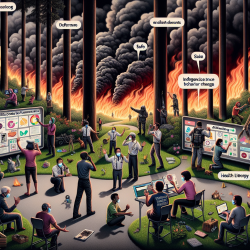Introduction
Wildfire smoke exposure is a growing public health concern due to the increasing incidence and severity of wildfires. The smoke contains pollutants that can lead to various health complications, making effective communication about its risks crucial, especially for vulnerable populations. A recent scoping review titled A scoping review of wildfire smoke risk communications: issues, gaps, and recommendations provides insights into improving these communications.
Understanding the Communication Gaps
The review highlights that current wildfire smoke risk communications often fail to adhere to health literacy principles, such as readability, accessibility, and actionability. This is particularly problematic for vulnerable groups, including children, the elderly, and those with pre-existing health conditions. The review identified several gaps in the research and evaluation of these communications, emphasizing the need for more targeted and effective strategies.
Key Recommendations for Practitioners
- Simplify Messaging: Use clear, concise language that is easy to understand. Messages should be direct and provide specific actions that individuals can take to reduce their exposure to smoke.
- Utilize Mixed Media Formats: Employ a combination of traditional and digital media, including social media, mobile apps, and maps, to reach a wider audience effectively.
- Focus on Vulnerable Populations: Tailor communications to meet the specific needs of at-risk groups. This includes providing information in multiple languages and formats to ensure accessibility.
- Enhance Community Engagement: Collaborate with local communities to co-develop communication strategies that are culturally relevant and resonate with the target audience.
- Prioritize Health Literacy: Ensure that all communications adhere to health literacy principles to facilitate better understanding and engagement.
Encouraging Further Research
The review calls for more intervention research and effectiveness evaluation of risk communications about wildfire smoke exposure. Practitioners are encouraged to contribute to this growing field by conducting studies that assess the impact of different communication strategies on behavior change and health outcomes.
Conclusion
Effective risk communication is essential in mitigating the health impacts of wildfire smoke, particularly for vulnerable populations. By implementing the recommendations from this review, practitioners can improve their communication strategies, ultimately leading to better public health outcomes.
To read the original research paper, please follow this link: A scoping review of wildfire smoke risk communications: issues, gaps, and recommendations.










